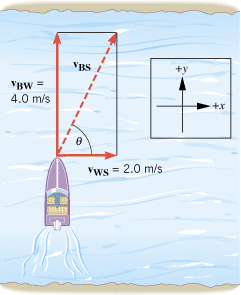The engine of a boat drives it across a river that is 1800 m wide. The velocity vBW of the boat relative to the water is 4.0 m/s, directed perpendicular to the current, as in Figure 3.18. The velocity vWS of the water relative to the shore is 2.0 m/s. (a) What is the velocity vBS of the boat relative to the shore? (b) How long does it take for the boat to cross the river?
 |
|
Reasoning
The velocity of the boat relative to the shore is vBS. It is the vector sum of the velocity vBW of the boat relative to the water and the velocity vWS of the water relative to the shore: vWS ![]() =
=![]() vBW+vWS. Since vBW and vWS are both known, we can use this relation among the relative velocities, with the aid of trigonometry, to find the magnitude and directional angle of vBS.
vBW+vWS. Since vBW and vWS are both known, we can use this relation among the relative velocities, with the aid of trigonometry, to find the magnitude and directional angle of vBS.
The component of vBS that is parallel to the width of the river (see Figure 3.18) determines how fast the boat moves across the river; this parallel component is  . The time for the boat to cross the river is equal to the width of the river divided by the magnitude of this velocity component.
. The time for the boat to cross the river is equal to the width of the river divided by the magnitude of this velocity component.
Solution


